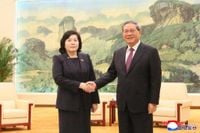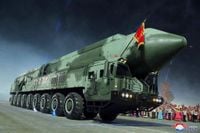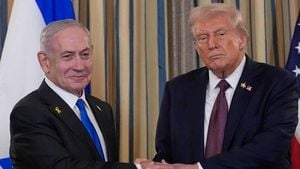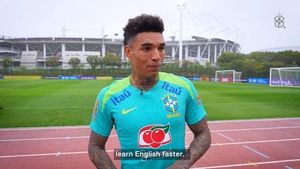North Korea’s capital, Pyongyang, is bracing for one of its most significant displays of military might in years as the country prepares to stage a massive parade on Friday, October 10, 2025. The event, marking the 80th anniversary of the founding of the ruling Workers’ Party of Korea, is drawing an unusual level of international attention—and not just for the weaponry expected to roll through Kim Il Sung Square.
According to Korea JoongAng Daily and The Independent, the parade is shaping up to be a pivotal moment in North Korea’s evolving foreign policy. For the first time in years, Pyongyang will play host to a high-powered lineup of foreign dignitaries, including Chinese Premier Li Qiang, Russian Security Council Deputy Chair Dmitry Medvedev, Vietnamese Communist Party General Secretary To Lam, and Lao President Thongloun Sisoulith. Their presence is widely seen as a visual demonstration of North Korea’s growing alignment with China and Russia, and a bold signal to the United States and its allies that Pyongyang is no longer as isolated as it once appeared.
China’s Foreign Ministry confirmed on Tuesday, October 7, that Premier Li will lead a party and government delegation to North Korea from Thursday through Saturday. This marks the highest-level visit by a Chinese leader since 2019 and a significant upgrade from 2015, when Liu Yunshan, then ranked fifth in China’s hierarchy, attended the 70th anniversary parade. "China and North Korea are traditionally friendly neighbors," a ministry spokesperson said. "Maintaining, consolidating and developing China-North Korea relations has always been the unwavering strategic policy of the Chinese [Communist] Party and government." (UPI)
Russia’s Medvedev, a close ally of President Vladimir Putin, will lead Moscow’s delegation, further cementing the sense of trilateral cooperation. North Korean state media and China’s Foreign Ministry both emphasized the official and goodwill nature of these visits, which follow a recent uptick in high-level contacts. In September, Kim Jong-un, Xi Jinping, and Vladimir Putin met as a trio for the first time at a military parade in Beijing, underscoring the deepening ties among these countries (The Independent).
For North Korea, the optics of Friday’s parade are crucial. Yang Moo-jin, a professor at the University of North Korean Studies, observed, "Sending Premier Li, the No. 2 in China’s leadership, shows goodwill in line with the restoration of North Korea—China ties. Placing Kim Jong-un between the second-ranking leaders of China and Russia during the parade will be a visual demonstration of North Korea’s strategic role and leadership on the Korean Peninsula." (Korea JoongAng Daily)
The parade is expected to showcase the latest advancements in North Korea’s military arsenal, with particular attention on its next-generation intercontinental ballistic missile, the Hwasong-20. Analysts anticipate the display of hypersonic missiles and other advanced weapons systems, which would represent a significant leap in Pyongyang’s strategic capabilities. On October 4, North Korea held a defense exhibition in Pyongyang, presenting new weapons including the Hwasong-11MA, a short-range ballistic missile equipped with a hypersonic glide vehicle. Kim Jong-un himself hinted at even more surprises, telling the Supreme People’s Assembly on September 21 that the country had developed new “secret weapons” and made substantial achievements in defense science—though he remained tight-lipped on the details.
"We are closely watching the U.S.' deployment of its means of strategic strike and reconnaissance […] and the mobilization for hostile acts in connection with a new possible threat to our state's security," Kim said during the event, as reported by Korea JoongAng Daily. He added, "They themselves should have to judge whether the territory of the ROK would be a safe place in any case," referencing South Korea by its formal name, the Republic of Korea.
South Korean officials, according to Yonhap, have detected movements of vehicles and military equipment ahead of the event, suggesting that tens of thousands of people are being mobilized for the parade. The timing of the event is also noteworthy: some analysts believe it is intended to undermine South Korea’s upcoming hosting of the Asia-Pacific Economic Cooperation (APEC) summit in Gyeongju later this month. Lim Eul-chul, a professor at Kyungnam University’s Institute for Far Eastern Studies, told Korea JoongAng Daily, "North Korea is clearly signaling its intent to play a role in building a multipolar order alongside China and Russia to counterbalance the United States. This looks like a strategy to resist diplomatic pressure from Seoul and Washington through socialist solidarity."
The parade’s guest list reads like a who’s who of the world’s remaining socialist states. In addition to the Chinese and Russian delegations, Vietnam’s To Lam and Laos’ Thongloun Sisoulith are expected to attend. For Vietnam, this will be the first visit by a national leader to North Korea since 2007, a detail highlighted by The Independent. Their presence, alongside Kim Jong-un, is expected to reinforce the image of a unified front against Western influence in the region.
Speculation is swirling about whether Kim Jong-un’s 12-year-old daughter, Ju-ae, will make a public appearance during the parade. Although she accompanied her father to China last month, she did not appear at any official functions—possibly due to her age or Chinese discomfort. South Korean intelligence, however, believes that her trip was intended to provide her with international exposure and strengthen her standing as a potential successor. Lim Eul-chul noted, "Given that Kim Jong-un is directing and producing this parade himself, there’s a high likelihood he will feature Ju-ae in a prominent supporting role to underscore her status and presence." (Korea JoongAng Daily)
The parade is not just about pageantry and spectacle. It’s a carefully choreographed message to the world, one that signals North Korea’s intent to step out from the shadows of isolation and assert a more active role in shaping the region’s future. By aligning itself more closely with China and Russia, Pyongyang is betting that it can resist diplomatic pressure from Seoul and Washington and secure its place in a multipolar world order.
As the sun rises over Pyongyang on Friday, all eyes will be on Kim Il Sung Square—not just for the military hardware on display, but for the new alliances and strategic ambitions being forged in plain sight.





